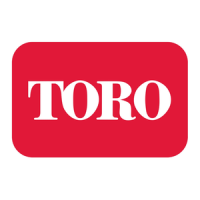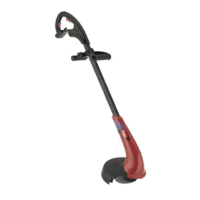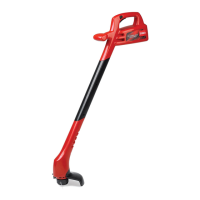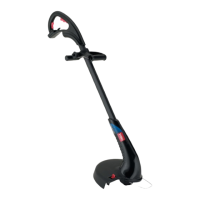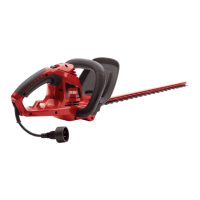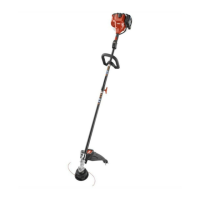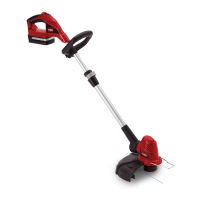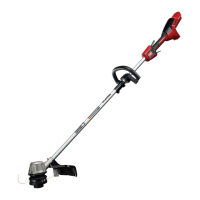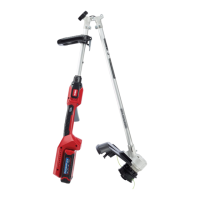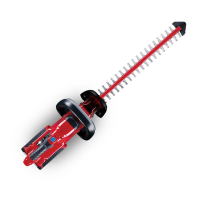Engine Inspection (cont’d)
maximum allowable clearance
0.08 mm (.0032”)
The difference between the recorded piston
outer diameter and the cylinder bore mea-
surement is the clearance.
If
the difference
is
greater than the maximum allowable clear-
ance, replacement of the piston, piston pin
and needle bearing
as a set
is recommended.
Engine Reassembly
All
parts, even if new should be thoroughly
cleaned. Make certain all parts have been
inspected and are within specification.
Do
not use worn and damaged parts. Use of
worn or damaged parts may cause personal
injury or engine failure.
1. Use finger pressure to install the two piston
rings on the piston.
IMPORTANT: The hemispherically notched
ends
of
the rings match the knock pins in the
ring grooves. Also note that the top side
(toward piston crown)
of
the ring
is
stamped
with a “T”. See Fig. 98.
Figure 98
2. Install one of the piston pin retaining rings in
the piston.
3. Insert the upper connecting rod bearing into
the connecting rod.
4. Install the piston on the connecting rod by
lightly lubricating the piston pin with clean
engine oil, positioning the piston onto the
connecting rod and pressing on the piston
pin. If necessary, the piston pin can be driven
into place by lightly tapping the pin with a
hammer and a non-marring punch or drift pin.
5.
Install the remaining piston pin retainer.
6.
If the main bearings have been removed,
install the main bearings into the crankcase.
7. Lightly grease the lips of the crankcase oil
seals to prevent seal damage when the crank-
shaft is installed.
Carefully install the crankshaft with attached
connecting rod and piston into thecrankcase
halves.
NOTE:
On the TC1000, both ends of the
crankshaft are the same.
8. Use sealant Three Bond 1104 (Toro part
number 505-80) on the gasket between the
crankcase halves. Position the gasket
between the crankcase halves and assemble
the crankcase halves with connecting rod
and attached piston.
Install the 4 screws with lock washers to
secure the crankcase halves together.
Tighten the screws to 0.4 to
0.5
kg m (35 to 43
in Ibs)
9. Install the cylinder upon the crankcase.
Position the cylinder gasket upon the crank-
case.
Make sure the pulse hole opening in the
gasket lines up with the crankcase opening.
Lightly lubricate the bore of the cylinder with
clean engine oil and carefully slide the
cylinder down the piston and onto the crank-
case. Note that the exhaust port is on the
right when the engine is viewed from the
recoil starter end.
IMPORTANT: The piston rings are aligned
with knock pins. Make sure that the end gap
is
aligned with these pins when inserting the
piston into the cylinder.
Secure the cylinder onto the crankcase with
the two hex. head screws with lock washers.
Tighten the fasteners to 0.4 to
0.5
kg m (35 to
43 in Ibs).
10. Install the spark plug into the cylinder. Make
certain the spark plug gap is set to
.6
to .7 mm
(.024
to .028”).
11. Screw
on
the starter pulley and secure with
the nut and the washer. Tighten to .8 to 1
.O
kg
m
(70
to 87 in Ibs).
12. Install the recoil assembly as described
under
Recoil Starter Installation,
page 29.
13. Install the flywheel, clutch shoes, tank and
coil as described under
Clutch Shoes and
Flywheel Reassembly,
page 31.
14. Install the muffler and muffler cover.
15. Install the carburetor and air cleaner as
described under
Carburetor Installation,
page 17.
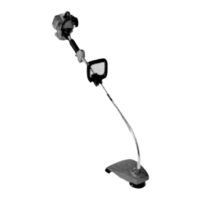
